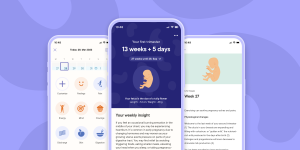Illustration by Marta Pucci
What it’s like to have a copper IUD

Every body is different, and people have a huge variety of experiences with the copper IUD. We reached out for personal stories, and here’s what you had to say.
There are many different brands of copper IUD worldwide, and many of these stories mention the specific brand. Some brands may only be available in certain countries, and may vary slightly in size and how many years they are approved for use.
“Getting an IUD is not as scary as everyone says it is”
I got a Paragard in November 2015. I chose it because it’s non-hormonal, lasts up to 10 years, and I don’t have to remember to take it. During and after insertion I had mild cramping and I spotted a little bit. So far the IUD has worked great and I have had no issues. I still have it. Getting an IUD is not as scary as everyone says it is. If you are worried about pain during insertion I recommend taking some Ibuprofen 30 minutes before.
—Crystal, female, 28 North Carolina, USA
“I went back to work the same day”
I had a Mona Lisa copper IUD inserted in 2015, because I wanted a form of birth control where I would still have periods. It was ok. The insertion was relatively uncomfortable (7/10 pain, then subsided to a 2/10 after the procedure). I was not offered any extra medication such as a cervix softener. I went back to work the same day.
—Anonymous, female, 26, Canada
“I think you really have to know your body before considering it”
I got my copper IUD during the summer of 2016, so I’ve had it for just over 2 years. I have the non-hormonal copper IUD.
I have anxiety and the idea of not having to remember to take a pill or check in on anything really appealed to me. Also, the pill had been really hard on my body—from weight gain to potentially suicidal thoughts at times. I wanted something without hormones and that could simplify the overall process, and my doctor recommended this!
Not going to lie, the insertion was unpleasant. My Gyno gave me a pill to soften my cervix but it just didn’t work on me at all. I guess I have a strong cervix! It was a pinching sensation and honestly I felt like it took an hour when it really only took a few minutes. However, after that I had pretty minimal cramping for about a day or so. Since then I’ve had zero problems physically, although it definitely made my flow dramatically heavier during my periods. I’ve only just mellowed out this year. BUT I credit it with regulating my cycle—not sure if that’s scientifically true but I’m incredibly regular, down to the day. I love that! [Note from the science team at Clue: You’re right Emma, there isn’t any research that suggests copper IUDs regulate menstrual cycles.]
I would wholeheartedly recommend it, but I think you really have to know your body before considering it. Because I was so in touch with the intimate details of my own cycle, I could spot abnormalities or shifts immediately after the insertion. Overall it’s been life changing for me in a good way, so I think it should be embraced!
Thank god OB/GYNs are embracing this as an option for younger women. I’m so glad my current Gyno was so supportive—my previous Gyno was not at all, and that was really hard to deal with!
—Emma Chikow, woman, 24, London, UK
“No hormones, and it’s a long term solution that I don't have to think about”
I got my IUD in July of this year, it's a copper one called Mona Lisa. I chose it because there’s no hormones and it’s a long term solution that I don't have to think about. It hurt a lot when I got it inserted but by the next day I felt normal. My first period [after the insertion] was painful and I lost a lot of blood but since then I've been totally normal.
—Niki, female, 25 Switzerland
“The best way to prevent another unwanted pregnancy”
After having an abortion, I decided the copper IUD could be the best way to prevent another unwanted pregnancy, since hormonal contraception didn't work well for me.
The insertion (on both times) was smooth—just an uncomfortable pinch and it was done. The positive side was to be able to stop using hormones altogether and also to spend long periods without worrying about an unwanted pregnancy. The negative side was the intense, painful cramps and the heavy flow (of 7-10 days a month) that eventually caused anemia.
I removed it after 10 years of use because of anemia caused by the heavy bleeding. Be sure to visit your doctor regularly and get your iron levels checked, as the heavy bleeding can cause anemia.
—Anonymous, female, 35, Portugal
“My IUD makes me feel like a cyborg in the best possible way”
I have a copper Paragard and have had it for just over a year. I got an IUD after I miscarried an unintended pregnancy. I had to have a D&C [Dilation and Curettage: a procedure where the cervix is opened and an instrument is inserted into the uterus to remove tissue] to resolve the miscarriage and my healthcare practitioner counseled to consider inserting the IUD after the D&C (in the same procedure) to minimize both physical and emotional trauma and to combine the recovery into one experience rather than two. Ultimately, I think this was a great decision and I'm grateful for her advice.
The fact that I was pregnant unintentionally showed me that my previous birth control method wasn't working for me and it was important for me to be in control of my fertility.
Overall I’m happy with the Paragard, and the peace of mind that comes with not having to make birth control decisions in the moment.
I had terribly painful cramps and very heavy bleeding during my periods for the six months following insertion, however, each period became more manageable and about a year out, my periods are back to my pre-insertion normal.
The insertion process was not fun. It's not. But you can get through it. My healthcare provider asked if i wanted to know all the details or just zone out during the procedure. For me, it helps to know exactly what's happening so I can be prepared for any sensations, pain or discomfort during a procedure. I'd recommend having this conversation with your provider beforehand so they know if you want to zone out or prefer to know the play-by-play. My IUD makes me feel like a cyborg in the best possible way.
—Anonymous, female, 33, Philadelphia, USA
“For four months my periods were unbearable, now I have no pain at all”
I didn’t want to worry about having kids yet, so in December 2017 I got a Lydia copper IUD (made in Nigeria). The insertion was mildly painful, and for four months afterwards, my periods were unbearable: painful, heavy and I felt weak. Now, I have no pain at all, and my period is only heavy on day two. I was prepared for the worst but overall, I would do this again. My advice? Do a lot of research, ask the gyno questions and just listen to your body.
—Enyi, cis woman, 23, Lagos, Nigeria
“What I enjoy the most is not thinking of my contraception”
I wanted a hormone free contraception and decided to get a copper IUD in August 2015. I was scared of insertion as I heard from a friend that it was painful, but it was way easier that I thought. After a few painful seconds, it was in and I have been very happy with it ever since. I have noticed heavier and more painful periods (mine were very mild to begin with) but it is very manageable.
What I enjoy the most is not thinking of my contraception. It is so freeing to know that I am protected whenever, and to feel my body functioning freely. I am glad that I can now notice how my organism normally works.
It is good to mention that on top of being one of the cheapest contraceptives (in France, it's about the price of four months of pills), it is also a more effective method because, there is no wrong way to use it.
—Nelly, female, 31, Paris, France
“I wish doctors would provide patients with more pain management options for IUD insertion and removal”
I got my Paragard IUD in January 2017 and had it removed in December 2018. I was anxious about the fate of the ACA (Affordable Care Act) after the 2016 election, and since I knew I did not want children in the next two years it seemed like the right time. Coming off of the pill, I also was interested in a non-hormonal birth control option, hence the Paragard.
My experience actually having the IUD was positive. I did not experience especially heavy or painful periods like I was warned with the copper IUD. I was able to track my cycles without the use of hormones, which cued me into some issues with my cycle that I have since been able to treat. My cycles were long and through fertility testing I found out I was hypothyroid, and have responded well to treatment. I also had a few months to learn how to track my ovulation without the pressure of actually trying to conceive. For these reasons, I don't regret my IUD.
However, the insertion and removal process were two of the most traumatic medical experiences of my life. I was not prepared for how painful the insertion would be, and I had a vasovagal response [when heart rate and blood pressure drop suddenly] that led me to faint. It took me a few hours to get my heart rate back to normal, so I spent some time in the emergency room being monitored. [Note from the science team at Clue: this is highly unusual. Usually people recover from a vasovagal episode in a few minutes.]
By the time I was ready to have my IUD removed, I went in for a routine appointment and my doctor was unable to find my strings. He ended up having to use a few tools to try to coax it out, which was extremely painful, uncomfortable and also unsuccessful. So to remove the IUD, I was scheduled for surgical removal. Thankfully, after my experience my doctor recommended using general anesthesia, but it was a draining process that knocked me out for a few days.
My husband and I are considering trying to conceive. Though I don't regret my IUD, I don't think I will opt to get one the next time I am interested in birth control just based on the insertion/removal processes.
Insertion and removal are considered routine, but they're still invasive processes. Talk to your doctor about how to manage pain before each of your appointments, and if he or she is able to provide you with anything stronger than ibuprofen, take them up on it. I would recommend an IUD if you are interested in a non-hormonal birth control option for an extended period of time. For me, if I was not concerned about tracking my cycle and wanted a hormonal option, I would prefer a more non-invasive method.
I can't stress enough how I wish doctors would consider the insertion and removal more of a serious procedure and provide patients with pain management options.
—Anonymous, female, 30, Pittsburgh, USA
“Don’t read horror stories online, speak to medical professionals instead”
I decided to try the T-Safe IUD after trying multiple types of hormonal methods, all of which had negative side effects on my mood. I had two IUDs inserted. The first one fell out partially which was horrifically painful and frightening. This was made worse as getting help from medical professionals was almost impossible—I was told the pain I was in was normal. It was an awful experience. 100% negative.
BUT after speaking to my new amazing doctor about what happened and how I was treated she was supportive and explained what went wrong. After speaking with her I wanted to try again.
The second time round the doctor was amazing and put me totally at ease. I felt crampy—the worst part is getting your womb measured, it felt like someone pinching you with tweezers on your cervix. After that I had strong cramps for a few days. It has made my periods heavy and more painful.
My experience with it has been mixed. It’s OK but not without its problems—like all contraception.
If you hate hormones and definitely don’t want to get pregnant then it’s great, but be prepared for longer and heavier periods. Also take time to speak to someone about what’s right for you and think about what side effects you are willing to put up with.
Getting it put in was scary and I read way too many horror stories online. My advice—don’t do that! Speak to actual medical professionals instead.
—Anonymous, female, 30, London, UK
We at Clue recommend that you see a healthcare provider to discuss which birth control is best for you, and let them know if you are experiencing any negative side effects.
Read more about birth control and check out Clue editor Amanda Cormier’s uneventful IUD insertion experience and writer Sam Slabyk’s copper IUD story.
Download Clue to track your birth control and cycle symptoms.




